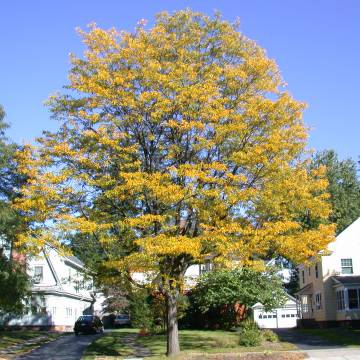

Gleditsia triacanthos - (image 1 of 8)
Taxonomy
Family: Leguminosae
Habitat
Moist, rich bottomlands and along rivers. Shade intolerant. Tolerant of alkaline and dry soils.
Associates
Acer saccharum, Celtis occidentalis, Fraxinus americana, Juglans nigra, Platanus occidentalis, Salix nigra, Ulmus americana.
Distribution
From the upper Midwest, west to the Dakotas, south to NM and west to the Pacific. Also part of NY state.
Morphology
Medium deciduous tree with a broad crown, sometimes flat-topped. Leaves alternate, once or twice pinnate compound. Singly compounds leaflets are produced early in the season or at the base of long shoot and bear 14-30 leaflets and no terminal leaflets. Double compound leaves have 4-7 pairs of branches and a terminal branch. Leaflets sometimes shallowly toothed. Flowers greenish-white, polygamous or monoecious, insect pollinated. Bark gray-brown, developing scaly ridges with age. Fruits are long, flat, twisted, and dark brown pods. Seeds are bean-like, hard, smooth, surrounded by a sugary substance. Twigs, branches and sometimes the bark produce long, smooth, sharp, reddish, often 3-branched thorns.
Notes
Flowers mid May to mid June
Wetland indicator: Facultative
A popular landscape tree because it doesn't cast strong shade, which allows grass to be grown beneath it. It sometimes produces good fall color, although it drops leaves early in the fall. It is often overused, often planted exclusively near buildings, in parking lots, and on streets. This has led to an increasing number of disease problems; it is usually better to use a variety of trees in the landscape.
The bark is similar to that of Kentucky Coffee Tree but the ridges are not as raised. This tree bears some of the most wicked-looking thorns in abundance, which is why most cultivars are thornless or nearly so. I must say that the thorns and seedpods of the typical species have an almost ornamental quality. One of the few trees that have root hairs.
The tissue surrounding the seeds has a sweet aroma similar to honeydew melon. It is sweet and generally regarded as being edible, but should not be confused with Kentucky Coffee Tree which has much shorter pods that contain a toxic pulp.
References
Dirr, Michael A. 1998. Manual of Woody Landscape Plants:
Their Identification, Ornamental Characteristics, Culture, Propagation and Uses.
5th ed. Champaign, Illinois: Stipes Publishing L.L.C.
Farrar, J. L. 1995. Trees of the Northern United States and Canada.
Ames, Iowa: Iowa State University Press
Peterson, L. A. 1977. A Field Guide to Edible Wild Plants: Eastern and central North America.
Houghton Mifflin Company. New York, NY
Swink, F. and G. Wilhelm. 1994. Plants of the Chicago Region.
Indiana Academy of Science. The Morton Arboretum. Lisle, Illinois.
|
Michael Hough © 2005 |